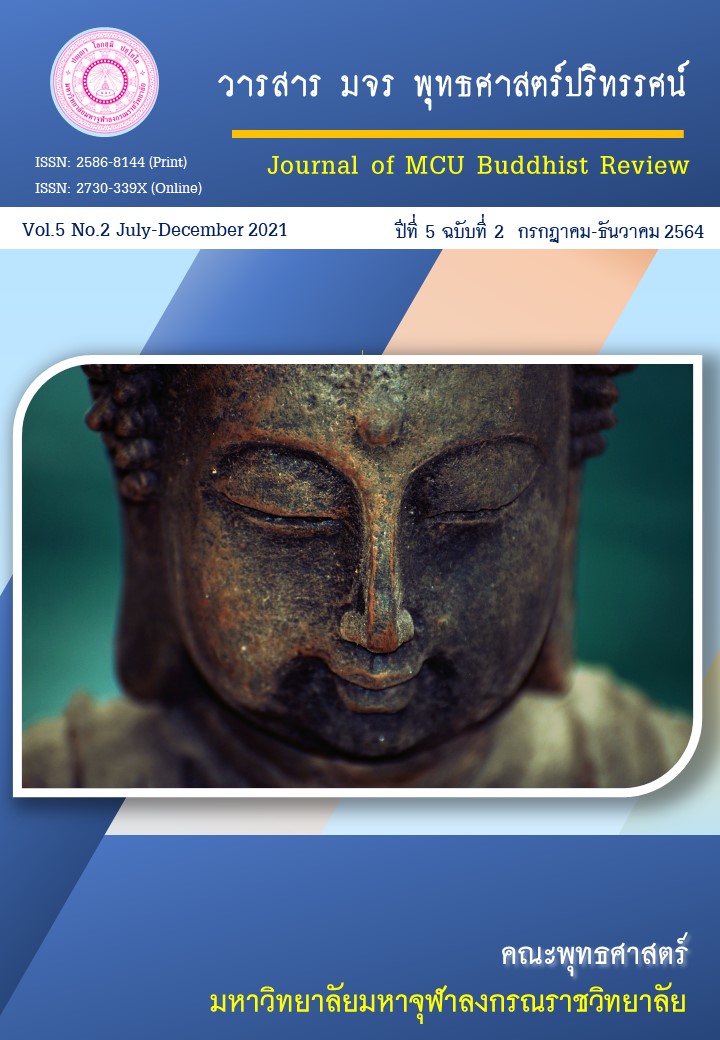การปฏิเสธอัตตาของพระพุทธเจ้าในพระไตรปิฎก
Main Article Content
บทคัดย่อ
บทความนี้ ผู้เขียน มีวัตถุประสงค์เพื่อศึกษาการปฏิเสธอัตตาของพระพุทธเจ้าด้วยหลักคำสอน (ทฤษฎี) ที่ปรากฎในคัมภีร์พระไตรปิฎก ผลการศึกษา พบว่า จากหลักฐานในพระไตรปิฎก พระพุทธเจ้าทรงกล่าวถึงอัตตาในความหมาย 2 ลักษณะด้วยกันคือ 1. อัตตาหรือตัวตน ที่เป็นภาษาสำหรับใช้เพื่อเป็นการสื่อสารและเข้าใจแบบชาวโลก (ชาวบ้าน) ทั่วไปเท่านั้น (สมมติสัจจ์) และ 2. อัตตาในความหมายที่เป็นอาตมัน คือภาวะที่ไม่เปลี่ยนแปลงดำรงตนเป็นอมตะ (ปรมัตถ์สัจจ์) ซึ่งอัตตาลักษณะที่ 2 นี้เอง พระพุทธเจ้าทรงปฏิเสธการมีอยู่โดยสิ้นเชิง ซึ่งเป็นสาเหตุแห่งความทุกข์อย่างไม่มีที่สิ้นสุดอีกด้วย โดยพระพุทธเจ้าทรงใช้หลักคำสอนหรือทฤษฎีตามที่ปรากฏในพระไตรปิฎก คือ หลักสัจจะ 2 ขันธ์ 5 ไตรลักษณ์ 3 และปฏิจจสมุปบาท เป็นเครื่องยืนยันและรองรับทฤษฎีดังกล่าว
Article Details
- บทความที่ได้รับการตีพิมพ์เป็นลิขสิทธิ์ของวารสาร มจร พุทธศาสตร์ปริทรรศน์
- ข้อความใดๆ ที่ปรากฎในบทความที่ได้รับการตีพิมพ์ในวารสาร ถือเป็นความรับผิดชอบของผู้เขียนบทความ และข้อคิดเห็นนั้นไม่ถือว่าเป็นทัศนะและความรับผิดชอบของกองบรรณาธิการวารสาร มจร พุทธศาสตร์ปริทรรศน์
เอกสารอ้างอิง
กรมศิลปากร. (2516). มิลินทปัญหา ฉบับพิศดาร. พระนคร. สำนักพิมพ์ศิลปะบรรณาคาร.
พระพรหมคุณาภรณ์ (ป.อ.ปยุตฺโต) (2555). พุทธธรรม ฉบับปรับขยาย. กรุงเทพมหานคร: พิมพ์ครั้งที่ 32. สำนักพิมพ์ผลิธัมม์ จำกัด.
มหามกุฏราชวิทยาลัย (2514). พระไตรปิฎกภาษาไทย ฉบับหลวง. กรุงเทพมหานคร: โรงพิมพ์มหามกุฏราชวิทยาลัย.
มหามกุฏราชวิทยาลัย (2553). วิสุทธิมรรค. กรุงเทพมหานคร: มหามกุฏราชวิทยาลัย.
วิทย์ วิศทเวทย์ (2542). อนัตตาในพุทธปรัชญา. กรุงเทพมมหานคร: โรงพิมพ์จุฬาลงกรณ์มหาวิทยาลัย.
วัชระ งามจิตรเจริญ (2556). พุทธศาสนาเถรวาท. พิมพ์ครั้งที่ 3 แก้ไขเพิ่มเติม. กรุงเทพมหานคร: สำนักพิมพ์มหาวิทยาลัยธรรมศาสตร์.
สมภาร พรมทา (2539). คือความว่างเปล่า พุทธปรัชญาว่าด้วยธรรมชาติของโลกและชีวิต. กรุงเทพมหานคร: จุฬาลงกรณมหาวิทยาลัย.
สราวุธ โพธิ์ศรีขาม.(2562). แนวคิดเรื่อง ตัวกู ของกู ในทัศนะของพุทธทาสภิกขุ. วิทยานิพนธ์ปริญญามหาบัณฑิต สาขาวิชาพุทธศาสน์ศึกษา ภาควิชาประวัติศาสตร์ ปรัชญา และวรรณคดีอังกฤษ. มหาวิทยาลัยธรรมศาสตร์.
Peter Harvey. (2013). An Introduction to Buddhism: Teachings, History and Practices. Cambridge University Press.
T. W. Rhys Davids (Thomas William Rhys) and William Stede (1952). The Pali Text Society's Pali-English dictionary. Edited by T. W. Rhys Davids and William Stede. LONDON: Biling and Sons Ltd., Guildford and Esher.
The Editors of Encyclopedia Britannica. (15 November 2021). " Atman Hindu philosophy". Britannica. (Online). https://www.britannica.com/topic/atman.
Gombrich, Richard F. (Richard Francis). (1937). What the Buddha thought. London: Equinox Pub.


